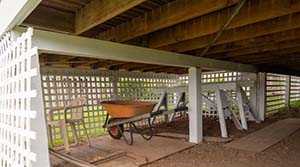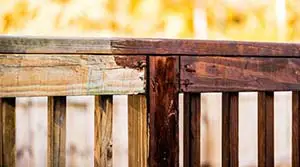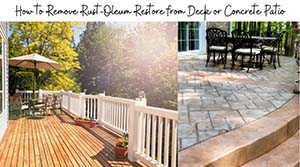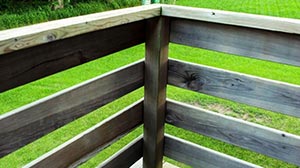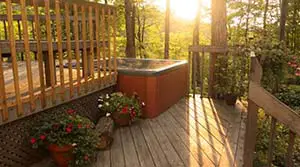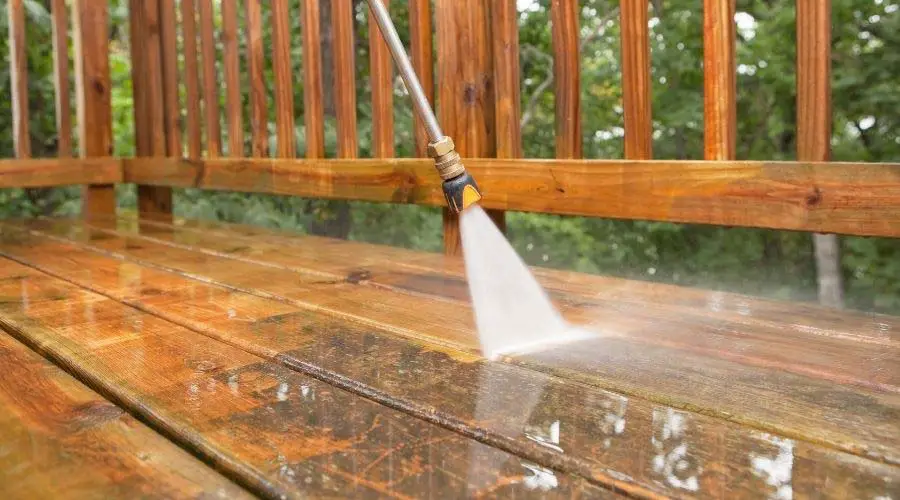
Does your deck have patchy stain or chipping paint? Old paint and stain can significantly diminish the appearance of your deck.
The best way to deal with this is to strip the surface of your deck and revitalize your exterior living area with a fresh coat.
There are many ways to strip old paint or stain from a deck. Whether you want to have it stained quickly or have long-lasting effects, here are six effective, easy ways to strip paint from a balcony:
- Use a gel-based stripper (effective stripping of multiple layers or oil-based paint)
- Liquid paint stripper (effective against latex & water-based paints)
- Avoid using chemicals while stripping paint & stain with a pressure washer
- Use an electric sander or grinder to remove resistant paint or stain areas
- A heat gun and scraper (makes quick work of stubborn spots)
- A combination of chemical stripper, pressure washing & sanding (provides the best results)
If you’re searching for effective ways to strip a deck, look no further. Here are six easy ways to strip paint or stain from a balcony. We will go over both chemical and mechanical techniques and combine these methods for the best result.
6 Easy Ways to Strip Paint or Stain from a Deck
Although we mentioned them above, it is essential to know the details on how to strip paint from a deck. Knowing more information helps you decide which one is best for you.
1. Use a Gel-Based Stripper (Effective Stripping of Multiple Layers or Oil-Based Paint)
If you aren’t opposed to using chemicals, a gel-based stripper is one of the easiest ways to remove old paint or stain from a deck. Due to the thick consistency of a gel-based stripper, it’s easy to apply precisely.
To do so, use a roller to apply an even layer and a brush to get hard-to-reach places. The viscosity of a gel-based stripper allows it to stick to vertical surfaces. This attribute helps remove stain or paint from surfaces like rails and box sills.
Gel-based strippers also remain moist the longest, letting the stripper remove several layers of paint and stain in a single application. If you have oil-based paint on your deck, it is a good idea to use a gel-based stripper to remove it.
Oil-based paints typically last longer and provide better protection against moisture because they penetrate deeper into the wood than other paints.
While oil-based paints do a long-lasting paint job, the removal process also makes that much harder. To make it easier, a gel-based stripper can lift the color off the wood without the need for any elbow grease.
The only drawback of a gel-based stripper, compared to other strippers, is that they take more time to apply and clean up.
This section should have given you a good understanding of whether a gel-based stripper is suitable for your deck. We’ll go over applying and removing paint and stain strippers in the following section, as the process is the same for both gel-based and liquid types.
2. Liquid Paint Stripper (Effective Against Latex & Water-Based Paints)
Liquid paint stripper is an excellent chemical remover for water-based and latex paints on your deck. You should note that a liquid paint stripper is only effective at removing one to two layers of color at a time. So, if you have multiple layers, you will have to make numerous applications of the stripper.
Liquid paint strippers are superior to gel-based strippers in that they evaporate much faster and are easier to clean up than gel-based strippers.
However, they can be difficult to apply precisely due to their liquid consistency. This consistency is also what makes liquid paint strippers more likely to damage outside fixtures around your deck than gel-based strippers.
To use a chemical paint and stain remover, like a gel-based or liquid stripper, first read the directions on the bottle. While we will provide general instructions, the paint remover you purchase will have specific guidelines for that product.
Chemical droplets fan out when you are rinsing the stripper off the deck. That’s why it’s important to cover areas that you don’t want the stripper to reach with tarps before you begin. You may want to protect nearby walls, railings, windows, doors, and especially plants.
Apply the stripper liberally, but don’t go flooding your deck. Once all areas with paint or stain are covered, give the stripper approximately 10-15 minutes to sit.
Check with the product description, but this should be enough time for the stripper to lift any paint or stain from the deck.
After the stripper has had time to set, you can use a power washer or hard-bristled scrub brush to lift off the remaining paint. Lastly, take a hose and give your deck a good rinse, removing any paint particles you see.
Benefits & Drawbacks of Using Chemical Stripping Agents
| Pros | Cons |
|---|---|
| Low cost. | Necessary to scrub the paint loose from the deck. |
| No need to rent or purchase expensive equipment. | You expose yourself and the outdoor area to caustic chemicals. |
| Little physical labor as the chemicals do the work for you. |
3. Avoid Using Chemicals While Stripping Paint & Stain with a Pressure Washer
Now that we have covered chemicals to strip paint and stain from a deck, let’s get into the mechanical methods. Pressure washers are one of the most efficient ways to remove anything from the surface of your deck.
The high-pressure levels can finish this task faster than most methods. However, you must be careful because if the water pressure is too high, it can easily damage the wood on your deck.
Even if it does not visibly damage your deck, it can still force water into the wood, causing it to rot or grow mold and mildew. To match the water pressure to the wood type of your deck, follow this table:
| Wood Type | PSI |
|---|---|
| Soft grain | 600-800 |
| Standard grain | 800-1200 |
| Rough grain | 1200-1500 |
When power washing your deck, safety is essential. Always wear safety glasses and closed-toed shoes to prevent the high-pressured water from getting in your eyes or removing the skin from your foot.
It’s also a good idea to cover your outdoor fixtures with a tarp to prevent them from being damaged in the crossfire.
Once you complete these precautions, you are ready to start power washing. Hold the pressure washer steadily at an angle. Keep the nozzle 12-18 inches away from the surface of your deck to ensure the water will penetrate the layers of paint but not damage your wood.
The most effective way to remove paint and stain is to work in sections. Keep the nozzle constantly moving while spraying in a side-to-side motion that follows the wood’s grain pattern.
Benefits & Drawbacks of Using a Pressure Washer
| Pros | Cons |
|---|---|
| No need to use chemicals | Potential to permanently damage the wood of your deck |
| Quick and easy | Purchasing or renting a pressure washer is expensive |
| A moderate amount of physical labor |
4. Use an Electric Sander or Grinder to Remove Resistant Paint or Stain Areas
While power washers are expensive and infrequently owned by most homeowners, sanders and grinders are much more inexpensive and commonly found. Though with the reduced price there are some obvious drawbacks.
For one, there is more physical labor involved as you will need to get down on your hands and knees to sand or grind every portion of your deck where you want paint removed.
Do not place too much pressure on the electric sander or grinder. Try to direct the tool and let it do the work.
Also, consider wearing a face shield or dust mask to avoid being harmed by dust and wood chips when using either of these tools.
By using a sander or grinder, you avoid the potential for water damage that can occur with a pressure washer.
However, if you excessively sand or grind the surface of your deck, you can altogether remove the texture of the wood. If the wood becomes smooth and non-porous, paint cannot adhere properly.
Grinders are handy for removing stubborn paint and stain that have resisted all other removal methods. In addition to wearing a face shield and a dust mask, use long sleeves, knee pads, and protective gloves.
It would help if you took precautions when using grinders. Unlike sanders, they have the potential to cut through metals.
To ensure you have the proper equipment, look for a grinder specializing in removing paint and stain surfaces off of wood.
Before grinding, take a punch and a hammer to recess all nails below the surface of the wood. It’s a pain to have your grinder hit a staple during the paint or stain removal process. Remember to let the tool float over the surface and not bear weight down when grinding.
Once you have removed the persistent paint or stain spots, clean your deck off to get it ready to be painted or stained.
Benefits & Drawbacks of Using a Sander or Grinder
| Pros | Cons |
|---|---|
| Tools are inexpensive when compared to pressure washers | Can remove texture from your wood deck, making it challenging to repaint |
| Excellent at removing resistant paint and stain areas | It takes more physical effort, better for spot removal of persistent stain and paints spots |
| No chemicals required |
5. A Heat Gun and Scraper Can Make Quick Work of Stubborn Spots
Most people don’t think of heat guns as a tool to remove paint or stain from a deck, but they can be beneficial. A heat gun is a small and inexpensive tool that packs a big punch to eliminate stubborn paint and stain spots on your deck.
By heating the surface of your deck, it breaks down the bond between the paint, or stain, and wood. With the glue dissolved, a scraper can get under the color and remove several layers at once.
Don’t plan on using a heat gun to remove paint and stain from the entire surface of your deck. While technically possible, this would take an excessive amount of time.
There are two primary ways to utilize a heat gun. One way is to use it to remove persistent paint and stain areas after you have gone over the whole deck with a pressure washer or chemical stripper.
Or, if your deck is in mostly good condition, remove problematic areas with the heat gun before painting over the entire deck.
Paint can adhere to paint as long as the underlying coat is good and has the same bases. Don’t apply latex paint over oil-based paint or vice versa.
In other words, you can avoid stripping your entire deck if you remove the problem areas before painting.
All you need for this method is a heat gun and a scraper. Heat the surface of your deck slowly to allow you to slide the scraper beneath the paint easily. Move the scraper forward until you feel resistance.
Once you feel resistance, it signifies that the section of paint you are working on needs further heating. Be extremely careful not to hold the heat gun too close to the surface of your deck.
It can potentially damage or warp the wood if it is overheated. When done correctly, removing paint or stain from a deck with a heat gun can be very satisfying as you scrape away long strips of color.
Benefits & Drawbacks of Using a Heat Gun
| Pros | Cons |
|---|---|
| It’s the most inexpensive way to remove paint and stainer without chemicals. | Physically demanding |
| Can lift multiple layers of paint at once. | Time-consuming |
| Potential to damage or warp wood of the deck |
6. A Combination of Chemical Stripper, Pressure Washing, and Sanding Can Provide the Best Results
This post explained mechanical and chemical methods separately. However, if you want the best results, you’re going to use a combination of these techniques. For each step, refer to previous sections on how to perform them.
You can remove all stain or paint by following these easy steps:
- Sweep any debris from your deck and cover sensitive surroundings with tarps.
- Use a liquid or gel-based stripper on the deck.
- Once the stripper has had sufficient time to loosen the paint, pressure wash the stripper and paint off the deck.
- If any stubborn areas of stain or paint remain, use a sander, grinder, or heat gun to remove them.
If you use this method, be aware that it will take more time and resources and provide the best possible results. If any paint or stain spots remain, repeating the process should remove them.
Sources

